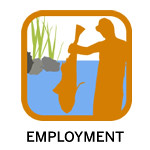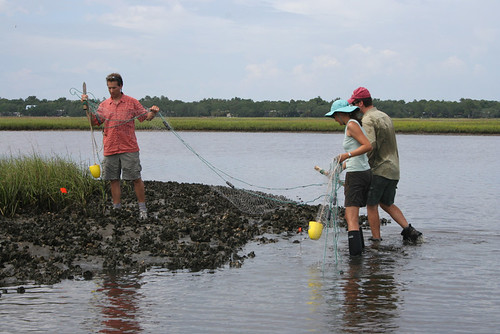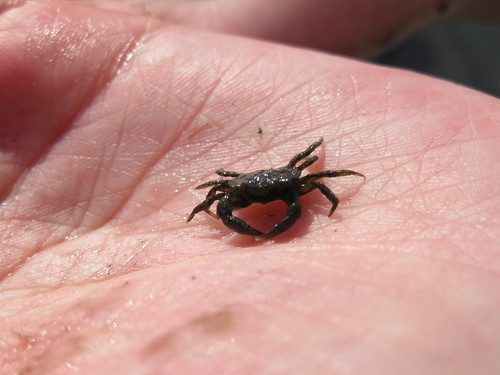 Along with David’s remembrances of his early life in marine biology, we have a video on one of David’s collaborators in this oyster study, Jeb Byers. Like all of the collaborators on the study, Jeb attended the University of North Carolina, where he overlapped with Jon Grabowski. Alicia Brown was sent up to help Jeb’s team during the October Oyster Push, so we lent her a Flip camera to document the proceedings. She got footage of some of the fish they caught, including the sharks that predate their reefs.
Along with David’s remembrances of his early life in marine biology, we have a video on one of David’s collaborators in this oyster study, Jeb Byers. Like all of the collaborators on the study, Jeb attended the University of North Carolina, where he overlapped with Jon Grabowski. Alicia Brown was sent up to help Jeb’s team during the October Oyster Push, so we lent her a Flip camera to document the proceedings. She got footage of some of the fish they caught, including the sharks that predate their reefs.
Dr. David Kimbro FSU Coastal & Marine Lab

L to R- Tanya Rogers, Dr. Jon Grabowski, Hanna Garland, and Dr. David Kimbro. Here you have three "generations" of researchers and techs. Just as David was once Jon's lab technician, Hanna and Tanya help David today with his projects.
Burrrrr….it’s cold down here and I love it…a nice break from the no see’ums! We are gearing up to hit the road for some regular sampling (water/sediment sampling and down load instrumentation) as well as to check on the tile experiment that began 6 weeks ago. Props again to Tanya for getting us organized to go! Although, I have some anxiety about what I’ll see on the tiles because the adhesive we used to affix the oysters may not be working as planned; more on that that in the next post after we get a visual on things.
For now, I want to pick up where Randall last left off by reminiscing about how I first got into the research/oyster business and how it’s all Jon’s fault. Like Randall, I graduated from the University of North Carolina at Chapel Hill and was equally clueless about what I wanted to do in life. However, I did know that the coast was where I wanted to be.
While Randall, Jon, and many others where schlepping around tons of oyster shell in the hot North Carolinian summer, I was having a good time surfing by day and waiting tables by night. All in all, I’d say that my summer was much more relaxing than theirs!
But after spending lots of time enjoying the coastal environment, I realized that I needed to look into this whole marine science thing. So, I began to nose around UNC’s marine lab and volunteered a little bit. By this time, Randall had taken off to teach middle school and Jon just got a prestigious offer to conduct research in Antarctica. But there was one glitch: who was going to run his oyster project in NC? He couldn’t just push the pause button on this research. Luckily, he had one last greater helper (Meg) whom he began training to be the boss. But she needed an underling. Enter me. Because they could not find a qualified research technician within three counties to hire, Jon decided to give ignorant me a shot. I was immediately told that the work was grueling and that the pay was peanuts. But I figured it had to be better than sitting indoors and watching the clock. Plus, Randall had already done the hard work by building all of those reefs; thank goodness I wasn’t on board for that madness!
Reaping the rewards from all the hard work that Randall and Jon exerted to build the oyster reefs, I got the easy work of just monitoring them and it was fun. When Jon returned from Antarctica, he saw that I hadn’t messed up anything too badly. That, coupled with my always asking him research questions made him decide to give me a little project of my own. And it is this experience that really sent me on my way into marine ecology. So, as I paddle my kayak out to the oyster reefs, think about interesting research questions, and enjoy the scenery, I often think back about the wonderful and fortuitous opportunity that Jon first gave me.
Ok, do I have any stories? Of course. One classic story that seems to get re-told every time Jon and I get together concerns our ripping up his restored oyster reefs to see what critters lived within them. Now, Jon was really interested in mud crabs, how they affected oysters by eating them, and how larger predators affected this dynamic by eating or scaring the mud crabs. So, while I (the rookie) was working through samples, he was a bit concerned that I was missing many of the smaller crabs. Knowing about his concern as well as being a little bit grumpy about being over worked and being a little naughty, I decided to leave about 5 or so pretty large mud crabs in my sieve. I then said, “hey Jon, to make sure I’m doing this correctly, will you check over my sample to see if I missed any crabs?”. By this time, I had already processed many, many hours worth of samples. So, when Jon looked at my sieve, he immediately freaked out and thought about how many of the other samples I must of messed up. Oh, I had such a good laugh. Thirteen years later, I think this story still gets Jon’s blood pressure up.

Years later, David heads his own team, and he and Randall are colleagues and collaborators with Dr. Grabowski.
What else…well, the winter work was so boring in North Carolina (lots of indoor time spent going through sediment samples) that I had to turn to coffee to help me make it through the late afternoon; with Meg’s persuasion (she was an addict and wanted some company). I stubbornly refused this drug all throughout college because I did not want to be an addict with smelly coffee breathe. But Meg was very persuasive and she started me out with small doses of Dunkin Donuts froofy, flavored coffees. Boy, this and some good 80’s music really helped me survive the late afternoon hours of sorting Jon’s samples in the lab. Next thing you know, I’m asking Jon for a coffee break (“hey man, can I take a quick trip to the Double D?”) every afternoon. Because Jon was a stingy boss (I say this with love), my and Meg’s new afternoon routine really annoyed Jon. But gosh, had I been open-minded about the joys of coffee back in college, I would have graduated with honors! In summary, the boringness of Jon’s project during the winter gave rise to my love of coffee (as Tanya eloquently captured in her last post), and it bugged the crap out of Jon…that and my caffeinated singing of 80’s songs in his lab during the later winter afternoons.
I could keep going with more stories, but I don’t want to give Tanya and Hanna any ideas or ammunition, so I’ll stop here.
Talk soon,
David


3 comments
[…] Alligator Harbor). The South Carolina sites of the biogeographic oyster study are sampled by Jeb Byers’ group. This entry was posted in In the Arts and tagged Apalachicola, forgotten coast, gulf of […]
[…] collaborators, hear funny stories about the crazy antics of Dr. Venerable Esteemed Professor when he/she was getting started as an ecologist back in the day, and relax and socialize with a group of […]
[…] in person than over a Skype conference call? However, I’m happy to be working with David, Jon, Jeb, and Mike “on the reef” despite the geographic distance. Not only are they the right people in […]
Comments are closed.